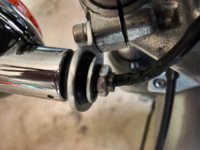Couperi
XS650 Member
Hey all, I'm clearly new to the xs650 community, and to motorcycles in general. Feel free to be harsh if my questions are ridiculous, I like to think I have a thick skin.
I do a fair amount of long rides on my '82 xs650, and I've been considering upgrading the ignition system to give myself some peace of mind. Safe to say I don't want to get stranded out in the Mojave when the stock system decides to fry out. To that end, I have a couple of questions:
- Would I be better off upgrading to Hugh's PMA with a Pamco ignition, or try to score one of Hugh's CDI kits?
- Would I still need to upgrade to Pamco if I got the CDI?
- I've also heard good things about the Powerdynamo system, but I'm not entirely sure if I understand it, or if it's even available? Anyone patient enough to explain it to me?
I do a fair amount of long rides on my '82 xs650, and I've been considering upgrading the ignition system to give myself some peace of mind. Safe to say I don't want to get stranded out in the Mojave when the stock system decides to fry out. To that end, I have a couple of questions:
- Would I be better off upgrading to Hugh's PMA with a Pamco ignition, or try to score one of Hugh's CDI kits?
- Would I still need to upgrade to Pamco if I got the CDI?
- I've also heard good things about the Powerdynamo system, but I'm not entirely sure if I understand it, or if it's even available? Anyone patient enough to explain it to me?

